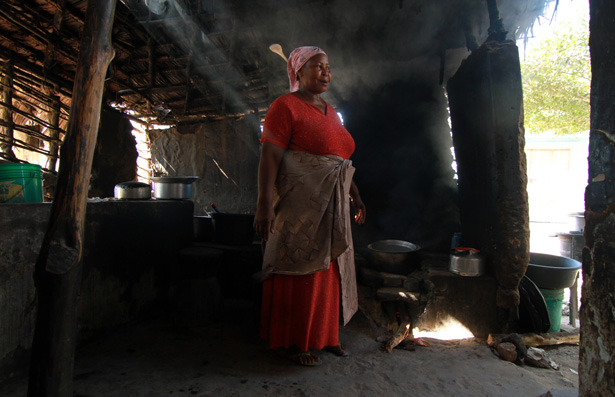-
10 Steps for Expanding the Population, Health, and Environment Approach
October 7, 2013 By Laura Henson
As their five-year funding cycle for supporting integrated population, health, and environment (PHE) programs around the world came to a close this fall, leaders from BALANCED Project – Building Actors and Leaders for Advancing Community Excellence in Development – came together at the Wilson Center to discuss lessons learned, best practices, and new ideas for the future.
Funded by USAID and run through the University of Rhode Island’s Coastal Resources Center (URI-CRC), Conservation International (CI), and PATH Foundation Philippines Inc. (PFPI), the BALANCED Project helped train 2,000 people from 72 organizations and eight countries in Asia and Africa on PHE approaches.
ECSP Director Roger-Mark De Souza challenged the panelists to provide 10 recommendations for future PHE programs, directed at practitioners, governments, and donors. The BALANCED leaders, Director Linda Bruce, East Africa Consultant Dr. Enrique “Ricky” Hernandez, URI-CRC’s Elin Torell, CI’s Janet Edmond, and PFPI’s Joan Castro, gladly complied:
- Continue to invest in Africa, especially East Africa. Bruce commented on the huge amount of need in East Africa and specifically suggested making resources available to overcome the challenges of working in remote villages and isolated areas (e.g., monsoons, poor infrastructure, and unpaved roads) where linking reproductive health and family planning with other key development priorities offer unique opportunities for policy and program application.
- Return to Madagascar. Since the military coup in 2009, the United States and other donors have pulled most of their aid from one of the most biodiverse regions of the world with a high unmet need for family planning. But Edmond pointed out that prior to that, there was a “huge, thriving PHE community,” and, as evidenced by programs like Blue Ventures which continue to operate, there is incredible demand.
- Invest in a centralized-funding framework that encourages partnerships. “The beauty of the BALANCED Project, which provided seed grants and technical support to a variety of partners, is that it encouraged buy-in from local partners that may not have had the resources to implement PHE on their own,” Torell said. Hernandez noted that organizations that are new to PHE in particular benefit from partnerships with experienced partners.
- Include enough money in seed grants for implementation and for long-term commitment so that there is enough time to gain evidence. PHE projects need time to build momentum, gain community buy-in, and scale-up. Building that long-term commitment into a grant helps ensure program sustainability and engender national government support.
- Look for more diversified funding. “Family planning grants often bear strict training and reporting requirements,” said Edmond, which challenges practitioners to fully incorporate health and environment initiatives into PHE projects. Exploring funding options that come from environment or other health donors could help.
- Take advantage of large international mandates, like climate change. Policymakers and practitioners are paying attention to climate change, and adaptation and resilience efforts share a similar focus on community-based, multi-sector development, Bruce explained. In order to encourage donors to think more holistically about development funding, connect PHE to these priorities.
- Use PHE to engage young people on environmental stewardship. “PHE is not about now, it’s about the future,” Hernandez said. As evidenced by enthusiasm from youth in the Philippines and elsewhere, young people often easily understand the connections between their local environment, their own health, and their futures. Take advantage of this to expand the reach of PHE programs through local champions and advocates.
- Contextualize the taking-to-scale conversation. “Stop trying to figure out one ‘magic-bullet’ PHE intervention that can scale-up,” Torell said. An integrated approach is “going to look very different in different contexts.” Bringing PHE to scale may simply mean introducing new programs to new contexts, rather than expanding existing programs to cover more.
- Think beyond traditional PHE hotspots. Rural, biodiversity-rich regions are not the only areas where PHE initiatives could be effective, said Castro. She suggested PHE programs could be effective in urban areas, focusing on agriculture and food security, and Edmond proposed coupling water, sanitation, and hygiene initiatives with freshwater conservation.
- Think beyond population, health, and environment. Castro described a PFPI initiative in the Philippines that is attempting to incorporate community resilience, energy, and education into existing PHE projects – a “PHE + E” program. Along similar lines, Edmond recommended exploring the incorporation of stronger gender components into PHE initiatives – a “PHE + G” approach.
The PHE approach begins at the community level, Castro explained. Beginning with local advocacy efforts and learning the local governance structure builds experience toward generating a “big bang” by ultimately aligning national government priorities with local PHE projects.
“The most important lesson I think we learned and validated is that PHE can be replicated and scaled up,” said Hernandez. “PHE was implemented in different settings within the context of improving people’s lives and addressing the issue of population pressure on natural resources.”
Overall, the BALANCED leaders were excited about the progress they’ve seen since 2008 and motivated to keep moving forward. “When people hear PHE they get it and they see the need,” Bruce said, “they may not know exactly how to do it, but they get it.”
Photo Credit: Sean Peoples/Wilson Center.
Topics: Africa, Asia, Beat on the Ground, biodiversity, climate change, community-based, development, energy, environment, environmental health, family planning, featured, From the Wilson Center, gender, global health, livelihoods, Madagascar, natural resources, PHE, Philippines, population, water, youth
 A Publication of the Stimson Center.
A Publication of the Stimson Center.



